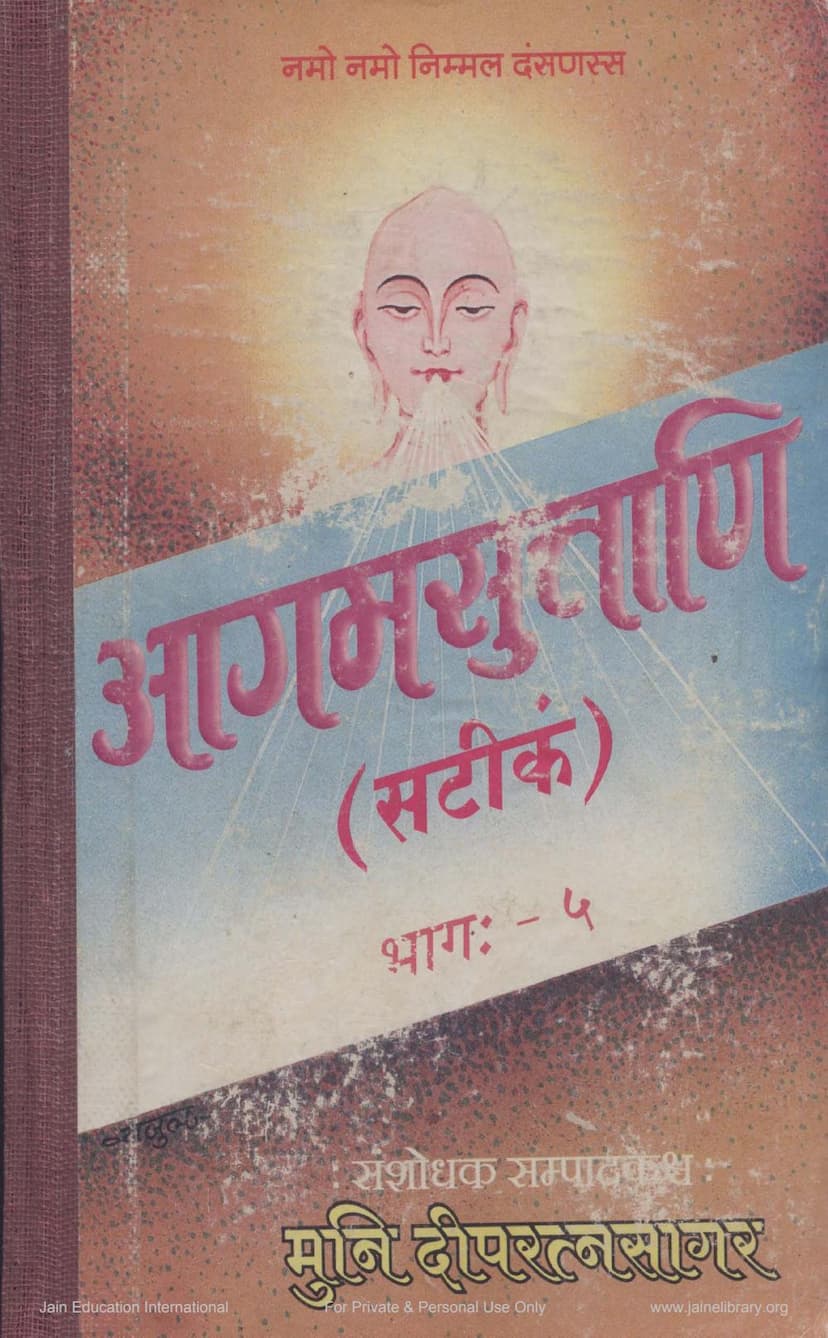Agam Suttani Satikam Part 05 Bhagvati
Added to library: September 1, 2025

Summary
Here's a comprehensive summary of the provided Jain text, "Agam Suttani Satikam Part 05 Bhagvati," based on the pages you've shared:
Book Title: Agam Suttani Satikam Part 05 Bhagvati (also known as Bhagvati Anga Sutra or Vyākhyā Prajñapti Anga Sutra)
Author(s): Dipratnasagar, Deepratnasagar (Compiler/Editor likely refers to Ropratnasagar as per page 2)
Publisher: Agam Shrut Prakashan
Core Summary:
This text, the fifth Anga of the Agamas, is the Bhagvati Sutra. It is a foundational text in Jainism, primarily presented as a dialogue between Lord Mahavir and his chief disciple, Gautam Swami. The Sutra is incredibly comprehensive, covering a vast array of philosophical, cosmological, ethical, and practical aspects of Jainism. It's known for its detailed discussions on various categories of existence, karmic principles, the nature of the soul, the structure of the universe, the characteristics of different beings (celestial, infernal, and terrestrial), and the path to liberation.
The provided text is the first volume (likely the first part of the first Shatak/Chapter) of this Sutra, with a commentary (Sāṭīka). The summary is derived from the table of contents (Vishayānukrama) and the introductory sections of the text.
Key Themes and Content Areas (based on the provided Table of Contents):
The Bhagvati Sutra, as outlined in the table of contents for the first ten Shataks (chapters), covers an immense range of topics, with each Shatak typically divided into ten Uddeshaks (sections or sub-chapters). These topics include:
- Cosmology and Geography: Descriptions of different realms, lokpalas (guardians of directions), heavens, hells, continents, oceans, and the structure of the universe.
- Jiva (Soul) and Karma: Discussions on the nature of the soul, its movement, characteristics of beings in different states of existence (from hell-dwellers to gods), the cycle of birth and death, and the intricate workings of karma (karma prakriti, bandha, udaya, nirjara).
- Sensory Perception and Faculties: Detailed explanations of the five senses (indriyas) and their interaction with the external world.
- Physical and Life Processes: Discussions on breath (ucchvasa, nishvasa), food (ahara), lifespan (ayu), and other biological processes.
- Metaphysics and Philosophy: Concepts like existence and non-existence, causality, the nature of reality, and various philosophical viewpoints, often contrasting them with those of other religious schools (anyatirthika).
- Ethics and Conduct: Discussions on vows (mahavratas, anuvratas), ethical principles, the consequences of actions (karma), and the path to liberation (moksha).
- The Nature of Lord Mahavir and Other Beings: Descriptions of Lord Mahavir's attributes, the characteristics of gods (celestial beings), hell-dwellers (nairayikas), and various classes of beings.
- Specific Topics: Detailed exploration of concepts like states of consciousness (leshya), knowledge (jnana), conduct (charitra), renunciation (virati), the importance of gurus, and various worldly phenomena.
- The Five Astikayas: Explanations of the fundamental Jain categories of existence: Dharma (medium of motion), Adharma (medium of rest), Akasha (space), Jiva (soul), and Pudgala (matter).
Specific Details Gleaned from the Provided Pages:
- Invocations: The text begins with invocations to "Nirmal Darshan" (Pure Vision) and Lord Neminath, highlighting the devotional and reverential tone of Jain scriptures.
- Structure: The table of contents clearly indicates the division of the Bhagvati Sutra into ten Shataks, each further subdivided into ten Uddeshaks, showcasing its methodical and exhaustive approach.
- Commentary: The presence of a commentary (Sāṭīka) indicates that this is an explicated version of the original sutras, making the complex philosophical concepts more accessible. The editor/compiler is noted as Ropratnasagar.
- Inspiration and Support: Page 6 and 7 list numerous financial supporters and spiritual guides whose inspiration and contributions made the publication possible. This highlights the collaborative nature of preserving and disseminating Jain scriptures.
- Introduction to the Sutra: Pages 8-11 contain an introduction to the Bhagvati Sutra, explaining its names (Bhagvati Angasutra, Vyākhyā Prajñapti Angasutra) and the author's intent to elaborate on it with the help of other commentaries. It also touches upon the importance of auspicious beginnings (mangal) in scriptures.
- The Namokar Mantra: Pages 11-12 detail the Namokar Mantra (Namo Arihantanam, Namo Siddhanam, etc.) and its significance, explaining the meaning and reverence due to each of the five supreme beings.
- First Uddeshak's Content: Pages 13-25 dive into the first Uddeshak of the first Shatak, discussing the initial dialogue about motion, karma, and the description of the city of Rajagriha and Lord Mahavir's assembly. The text also begins to discuss the concepts of "chalantam chalitam" (moving and moved) in the context of karma.
Overall Significance:
The Bhagvati Sutra is considered an encyclopedic work within Jainism. This specific volume, part of the Agam Shrut Prakashan series, aims to present this profound scripture with a guiding commentary, making its rich teachings accessible to a wider audience for personal and educational use. The detailed breakdown of topics indicates the Sutra's systematic approach to explaining the Jain worldview.